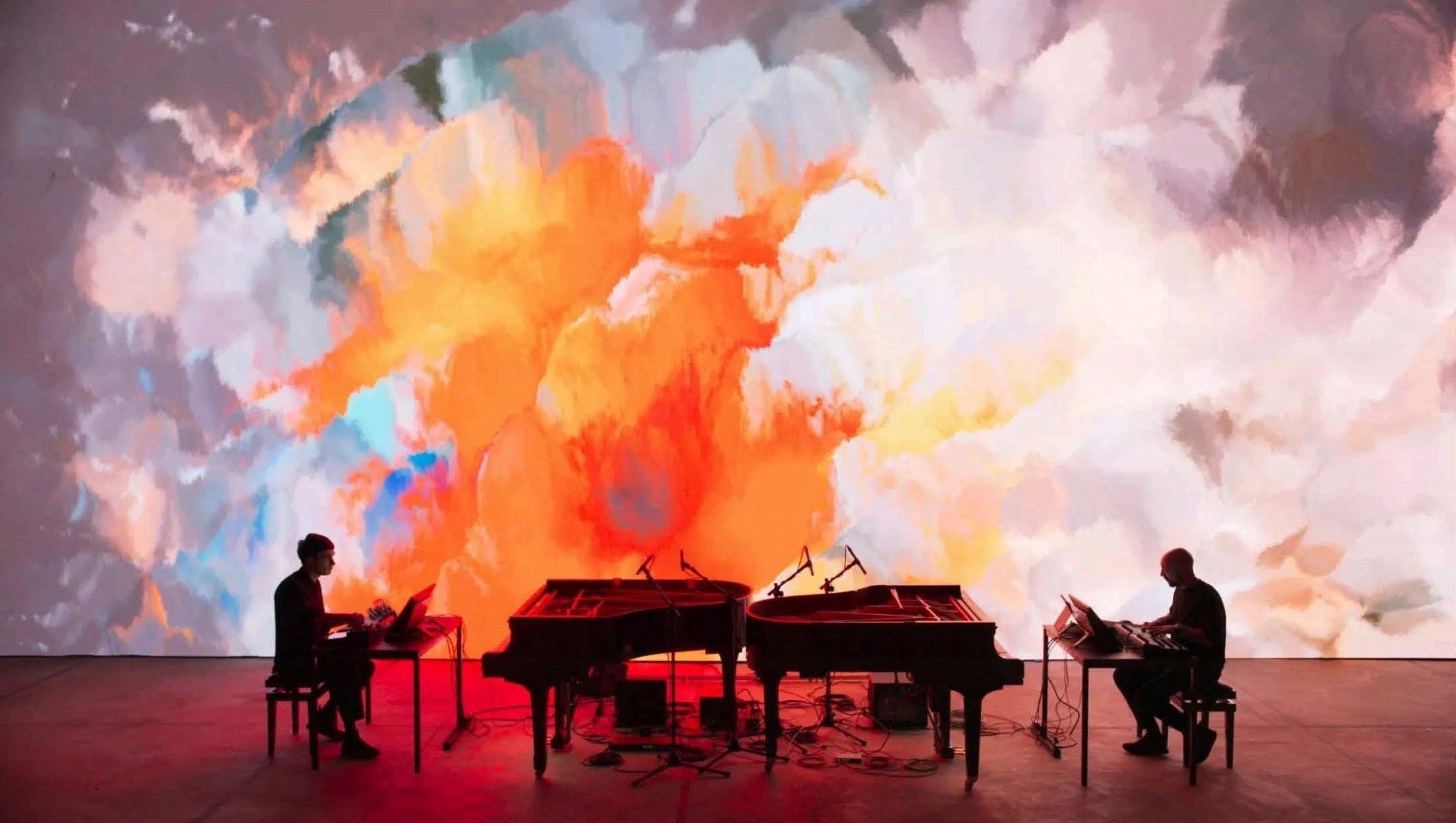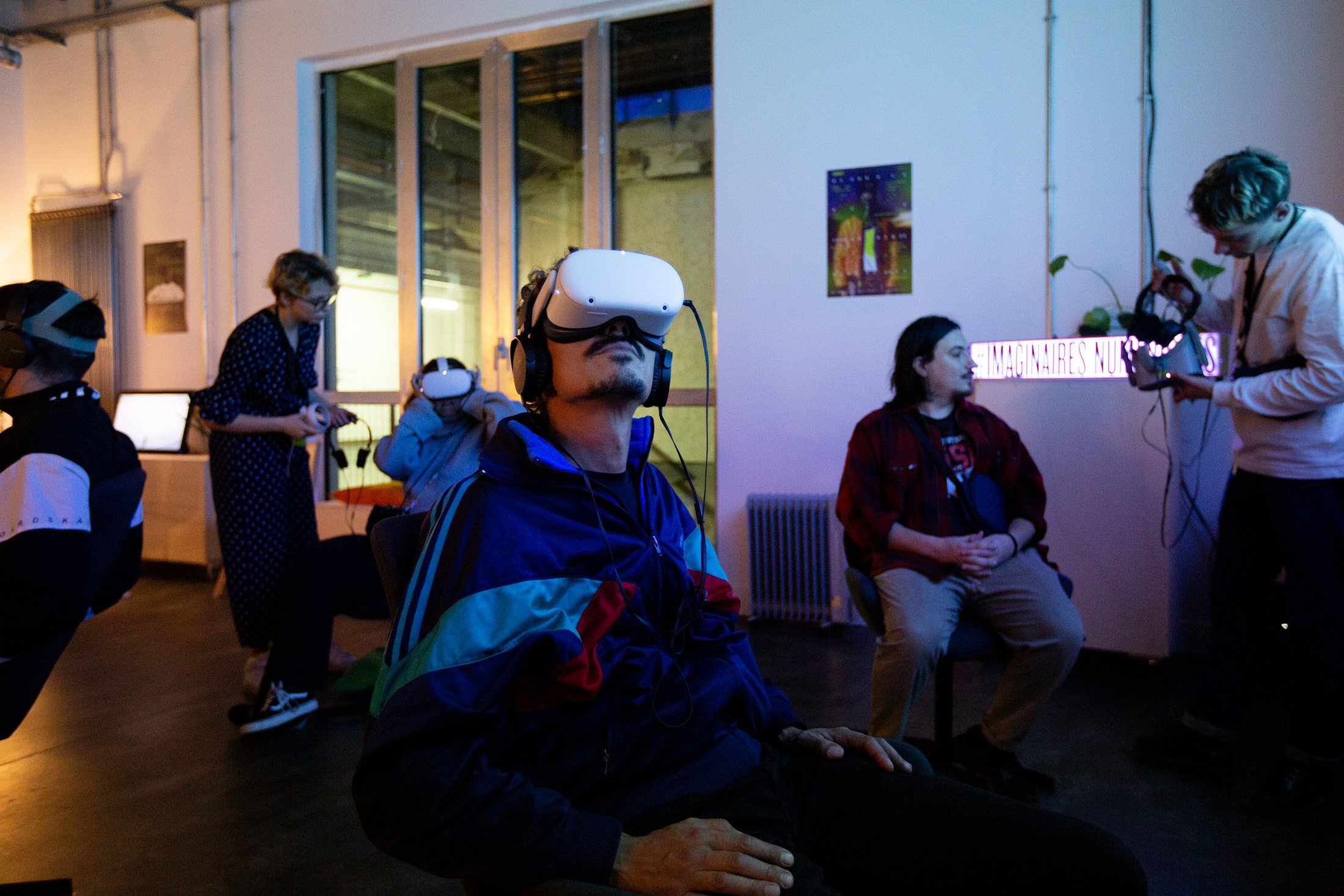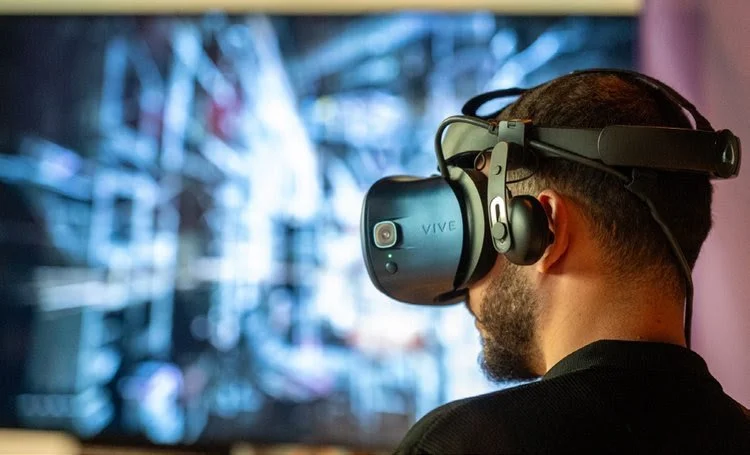
Digital Inter/Section Newsroom.
Press Release February, 2025.
DI/S Impact and Tools for the Creative Sector
Case Studies of Business Models, Tools, Takeaways and Coverage
DI/S - Digital Inter/Section, a project supported by the Creative Europe programme of the European Commission, is moving into its final phase. During a four year period, a group of European digital arts organisations at the forefront of digital have explored ways to develop business models while maintaining artistic integrity. The impact of digital arts organisations surpasses the creative sector, they foster a cross disciplinary approach by building bridges between creativity, tech, science and community. The legacy of the project, case studies, reports and key takeaways are available as open source on the website to benefit digital arts organisations and the creative sector at large.
MIN/Chroniques, Realities in Transition, Photo: ©Pierre Gondard.
The Impact of Digital Arts Organisations
Digital arts organisations are reaching wide audiences through biennials and festivals. With competence in experience-based environments, and in both digital society and literacy, digital arts organisations are hybrid organisations operating with complex sets of income streams, from public funding to private and self-generated income.
A key question is how digital arts organisations can bring in a business mindset while maintaining artistic integrity as major producers of digital art? Digital arts organisations are at the forefront of digital. With expert areas beyond the traditional expertise of traditional arts organisations, and with an impact surpassing the creative sector, they foster a cross disciplinary approach by building bridges between creativity, tech, science and community while maintaining strong values and artistic integrity. DI/S - Digital Inter/Section, a project supported by the Creative Europe programme of the European Commission, offers a range of tools and case studies with new business models aimed at digital arts organisations and the creative sector.
Can the cultural sector contribute to economic growth? The relationships that exist between this market’s segments are symbiotic. This means that advances in one part stimulates growth in other parts of the creative economy but also beyond. For example, Chroniques, supported by the case study Chroniques, Market of Digital Imagination Fair, is advocating for mobilising public funds earmarked for economic growth, and not only for the cultural sector.
More information, including links to open source tools, case studies, and press images below.
Press Release December, 2024. (Updated January 2025)
Digital Arts Organisations X New Business Models - Case Studies Released
How can digital arts organisations bring in a business mindset while maintaining artistic integrity as major producers of digital art? DI/S - Digital Inter/Section, a multiyear project supported by Creative Europe, is releasing four case studies of new business models for digital arts organisations and the creative sector. Some of the key finds include a strong audience perspective and that funding through a diversification of income streams, independent of public or private funding, creates stability and sustainability.
Media Lab. Galaxy-Lab. Credit: Chroniques
DI/S - Digital Inter/Section, a project supported by the Creative Europe programme of the European Commission, is releasing four case studies with new business models aimed at supporting digital arts organisations and the creative sector. The case studies and other resources are available as open source through the project’s website.
The Four Case Studies by DI/S - Digital Inter/Section
Chroniques, Marseilles, France
Case Study Chroniques - Market of Digital Imagination Fair
The Market of Digital Imagination Fair (MIN) is an event for professionals in the cultural and creative industries focused on new technologies and digital creation.
The marketplace deepens the connection between art and technology, foster R&D, and cultivate innovative partnerships. Building on the Biennial of Digital Imaginaries, an artistic event, MIN capitalises on the organisations’s ability to break down barriers and bring different economic sectors together. By connecting artists, tech innovators, and cultural leaders, it is exploring sustainable models for visibility and collaboration. MIN was initiated in 2024 and comprised two days of demonstrations, panels, masterclasses, keynotes speeches and pitches and offered the opportunity to meet hundreds of national and international professionals.
Digital cultures and organisations have developed around the very idea of networks and collaboration. The marketplace as a model encourages this to continue and allows for an event-based and experiential approach to the development of new B2B services. Chroniques is hybridising its revenue streams by generating B2B revenue and by developing a customer-centric approach.
A key takeaway from this case study is that the development of the Market of Digital Imagination Fair (MIN) supports Chroniques’s advocacy to convince public decision-makers of its cross-sectoral role, in particular by mobilising public funds earmarked for economic growth, not only for the cultural, sector.
Establish clear values and objectives from the beginning because they will guide every decision.
Stay adaptable, because during the year, we learnt that digital creation and public funding are always changing.
To pay special attention to our community and the international audience because it’s really important to imagine always having the possibility to gather people to exchange ideas and new projects.
Bianca Farrugia, Production manager - MIN and Céline Berthoumieux, Co-director - Chroniques.
Key Opportunities for Digital Arts Organisations
→ EXPERIENCE-BASED ENVIRONMENTS
→ HYBRIDITY
→ UNDERSTANDING OF DIGITAL SOCIETY
→ DIGITAL LITERACY
→ COLLABORATIVE ECOSYSTEM
Signal Festival 2023. Credit: ©Tomas Slavik
KIKK, Namur, Belgium
Case Study KIKK - Klub Pavillon
Klub Pavillion raises awareness of sponsorship dedicated to digital creativity through the creation of a members' club that supports a new exhibition space.
In 2022 KIKK opened an exhibition space in Namur (Belgium) dedicated to the digital experience that increased the organisation's dependence on public funding. To reduce this dependence, KIKK has looked into developing new private support through a members' club, based on adherence to the project and its values, that guarantees a unique offer to members while securing funding for an exhibition space for digital art that is open around the year.
Several solutions to diversify income streams have been tried and developed, such as creating traveling exhibitions funded by successive rentals and developing a so-called horeca area that combines hotel, restaurant and catering. Integral to KIKK - Klub Pavillon, which is launching in January 2025, is to unite the community of individual and professional patrons around the values of the project such as education, awareness, scientific popularization and to offer a unique programme.
A couple of takeaways from this case study are the importance of strategic analysis to align the club’s offer with the Pavillion’s programme and of working towards a deadline and a fixed sum for the Pavillion Klub patronage.
In 2020 we decided to make a transition from an event based model to a permanent structure.
Now we have opened a space for public awareness where accessibility of content is the key.
Gilles, Bazelaire CEO and Founder
Our first challenge was to conduct an audit of our meaningful and significant offering, and to map our network of potential partners and members. As a small organisation, we need to leverage what already exists and ensure a good balance between sponsorship packages and talent offerings with some of the selected partners.
Chloé Gerard, Partnership Manager.
KIKK 2024. Credit: ©Quentin Chevrier.
MIN, la Cartonnerie de la Friche la Belle de Mai at Art-O-Rama, Marseilles. Credit: ©Caroline Dutrey
KONTEJNER, Zagreb, Croatia
Case Study Kontejner - Experiments with sustainable venue management
The Zagreb case study revolves around experimenting with economic sustainability and community engagement for KONTEJNER’s new venue, a small centre for contemporary art practices.
The goal for KONTEJNER was to create more sustainable and diversified funding to support its new venue, and to foster community development by reaching new audiences and partners, and converting them into supporters of the venue.
KONTEJNER developed and tested a series of experimental actions, including launching a new company, monetizing spatial resources, designing membership packages for citizens and partners, and collaborating with architectural experts to explore new uses for the venue’s outdoor space.
Instead of working with the usual ones from the cultural/creative, academic and scientific sector, KONTEJNER collaborated with new partners from the business sector such as private companies, professional associations and corporations.
A key takeaway from this case study is that innovative practices and development can be turned into a catalyst for a new organisational ecosystem that favours circular economy models and social entrepreneurship, generating new benefits for the broader cultural sector.
The Zagreb pilot project is all about experimenting with sustainable venue management.
We wanted to strengthen connection with our existing audiences while reaching new ones.
The membership packages for our audiences /are tailored/ to turn them into contributors.
Jadrana Ćurković, Communication and marketing consultant.
Signal Festival 2023. Credit: ©Tomas Slavik
Signal Festival, Prague, Czech Republic
Case Study Signal Festival - New business model targeting ticketing and audience strategy
The goal of the pilot project carried out by Signal Festival was to ensure long-term financial sustainability and enhance the visitor experience through the optimization of ticketing models, improved audience segmentation, and the redefinition of premium products such as the Gallery Zone.
Signal Festival, the largest digital art festival in the Czech Republic that draws 500,000 to the streets of Prague, is evolving its business model to reduce reliance on public funding. The project represents a significant shift in the festival's business model, focusing on premium experiences and data-driven segmentation to ensure long-term sustainability and a deeper connection with its diverse audience.
A key takeaway from this case study is that by targeting both mass and niche audiences, the festival aims to secure long-term growth while maintaining artistic integrity and developing visitor experiences - thus putting audience perspective and artistic integrity at the centre.
First, diversify your revenue streams. Explore paid options for your audience to complement B2B partnerships and public funding.Invest in understanding your audience. Research into visitor behaviour and expectations gives you the insights needed to create real value.
Work with qualified experts. Collaboration with professionals, like our research agency, was key in validating data accurately.
Martin Pošta, CEO
Signal Festival is committed to sustainability. We strive to minimize our environmental impact by digitizing the ticketing process, reducing waste and through recycling sourcing locally. We also educate our visitors about environmental issues through our artworks.Alzbeta Krajcikova
Strengths and Challenges
The digital arts organisations that joined to form DI/S are diverse but share many strengths and challenges.
They are united by a high understanding of digital society and experience-based environments and strong networking and collaborative skills, while being challenged by how to identify new revenue streams without compromising creative credibility and how to bring in a business mindset in organisations partly funded by public funds.
The local pilot projects prove that digital arts organisations and private companies can meet around several stakes and that they can guide one another towards new narratives, opportunities and knowledge, contributing to their respective economic development and proposing new ways to implement their Corporate Social Responsibility (CSR) policy.
Opening night at KONTEJNER, Zagreb; September 2023.
Credit: ©Sanja Bistričić Srića.
The Impact of Digital Arts Organisations
Digital arts organisations are reaching wide audiences through biennials and festivals. With competence in experience-based environments, digital society and literacy, digital arts organisations are hybrid organisations operating with complex sets of income streams, from public funding to private and self-generated income. Digital arts organisations are at the forefront of digital. With expert areas beyond the traditional expertise of traditional arts organisations, and with an impact surpassing the creative sector, they foster a cross disciplinary approach by building bridges between creativity, tech, science and community while maintaining strong values and artistic integrity.
Can the cultural sector contribute to economic growth? The relationships that exist between this market’s segments are symbiotic. This means that advances in one part stimulates growth in other parts of the creative economy but also beyond. For example, Chroniques, supported by the case study Chroniques - Market of Digital Imaginaries, is advocating for mobilising public funds earmarked for economic growth, and not only for the cultural sector.
Transient – Impermanent Paintings, Quayola (IT), Andrea Santicchia (IT), Chroniques Biennale. Credit: Quayola Studio. Photo© Skino Ricci
Media Resources
Download case studies on DI/S Digital Inter/Section website.
Download the report The Business of Digital Art: Economic Models and Insights Into the Future on DI/S Digital Inter/Section website.
Interviews on YouTube
Download full press release DI/S Impact and Tools for the Creative Sector. February 2025
Download full press release Digital Arts Organisations X New Business Models - Case Studies Released with additional quotes. December 2024/January 2025
Download full press release KONTEJNER iz Zagreba razvija nove poslovne modele za kulturne organizacije digitalne umjetnosti in Croatian January 2025
Press contact:
Sofia Bertilsson, Art Insider PR
sofia@artinsiderpr.com
Notes to editors: About DI/S - Digital Inter/Section
DI/S - Digital Inter/Section is a joint project by digital arts organisations in Germany, Belgium, Canada, Croatia, France and the Czech Republic supported by Creative Europe. Started in 2021 the project moves into its final phase 2025 by releasing four case studies to support the Creative and Cultural Sector in Europe and beyond.
The aim of the project has been to experiment and diversify the revenue streams and business models of digital art organisations while promoting sustainable, ethical and inclusive economic development, essential for a digital shift in line with European values.
Each of the four artistic partners, CHRONIQUES, KONTEJNER, Signal Festival, KIKK, has conducted pilot projects in their own territory, working together with private companies that have helped the diversification of their revenue streams. These experiences are shared among the consortium to inspire each other and generate collective convergence. Apart from the organisations involved in the pilot projects, Digital Inter/Section benefits from two supporting partners, The CATALYSTS and Chromatic, Canada. By experimenting and developing new innovative business models for digital arts and culture organisations, Digital Inter/Section increases these organisations’ competitiveness, their economic resilience as well as their employees and the artists’ they produce and curate. By doing so, DI/S inspires the whole CCS sector to take the leap.
Download press images:

Transient – Impermanent Paintings, Quayola (IT), Andrea Santicchia (IT), Chroniques Biennale. Credit: Quayola Studio. Photo© Skino Ricci

Biennale-Chroniques Friche. 2022. Credit: ©Pierre Gondard.

MIN, la Cartonnerie de la Friche la Belle de Mai at Art-O-Rama, Marseilles. Credit: ©Caroline Dutrey

Ouvertures 2022. Chroniques. ©GrégoireEdouard.

Ouvertures 2022. Chroniques. Credit: ©Grégoire Edouard

Signal Festival 2023. Credit: ©Dusan Vondra

Signal 2023. Credit: ©Tomas Slavik

1-er jour des rencontres. Credit: © Grégoire Edouard.

Media Lab. Galaxy-Lab.

Signal Festival 2023. Credit: ©Tomas Slavik

Signal 2023. Festival Credit: ©Tomas Slavik

Signal Festival 2023. Credit: ©Tomas Slavik

Signal Festival 2023. Credit: ©Tomas Slavik














